In Memoriam: The People’s President: A.P.J. Abdul Kalam
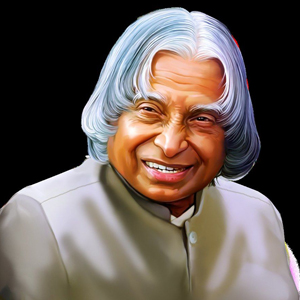
President Kalam’s authenticity gave him the ability to be a force in every forum—whether it was the United Nations or a rural village school—and to connect with every individual regardless of wealth, social standing, age, or education. Leaders like Kalam are needed today more than ever before.
Ironically, my journey to learn more about President Kalam started at Mayura, my favorite Indian restaurant in West Los Angeles. In an area where plush Indian restaurants dot the landscape, Mayura is unpretentious and family-friendly. One wall is covered with pictures of President Kalam standing informally with the restaurant’s owners and staff.
Curious about this unusual display, I asked Padmini Aniyan, Mayura’s owner, about it. She recalled the time when she had received a call from the Indian Consulate in San Francisco asking if she could reserve the restaurant for President Kalam’s visit. Aniyan remarked, “I do not have any words to explain my experience. He was the most down-to-earth, humble person. I have seen so many celebrities such as Jack Nicholson, AR Rahman, and others who have visited us, but no one was nearly as impactful as Kalam! He asked about my background, and I told him I had been a business professor in India and was now in business for myself. He told me, ‘Whatever you do, put your 100 percent and do not worry about the outcome. If you do the right thing, the right thing will come back to you.’” Continuing, Aniyan stated, “When I see his picture on the wall, his words come to my mind.”
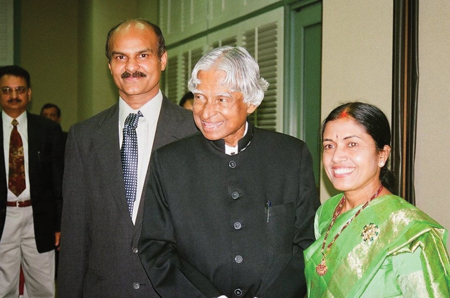
[Right] “Whatever you do, put your 100 percent and do not worry about the outcome. If you do the right thing, the right thing will come back to you.” These are the words of President Kalam that have stayed with Padmini Aniyan, owner of Mayura restaurant in West Los Angeles.
Aniyan’s experience reflects Kalam’s own authenticity which gave him the ability to be a force in every forum—whether it was the United Nations or a rural village school—and to connect with every individual regardless of wealth, social standing, age, or education. Leaders like President Kalam are needed today more than ever before.
This led me to wonder: What is it about President Kalam’s life journey that makes him such an inspirational yet humble leader? What can I learn from it?
Exposure to coexistence from early childhood
Kalam’s virtues of tolerance and syncretism were fostered by his upbringing and early life experiences. He was born in 1931 to a Tamil Muslim family in Rameswaram, Tamil Nadu.. The youngest of five children, he came from a family of simple means. His father, Jainuladeen Marakayar, owned a ferry business and was the Imam of the local masjid. In his book, My Journey, Kalam wrote, “[Rameswaram’s] small local population consisted of mostly Hindu house- holds with a sprinkling of Muslims like us, and Christians too. Each community lived in healthy contentment next to each other. The divisions and vicissitudes of the outside world rarely made their way here. The daily papers brought news of upheavals and communal fault lines being drawn elsewhere, but here, life continued at its age-old leisurely pace”
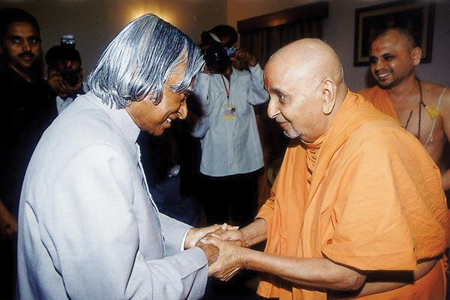
[Left] In his book, Transcendence: My Spiritual Experiences with Pramukh Swamiji, Kalam writes fondly and reverentially about the Late Pramukh Swami of the Bochasanwasi Akshar Purushottam Swaminarayan Sanstha (BAPS).
The town’s Ramanathaswamy Temple, dedicated to Lord Shiva, is one of India’s most popular pilgrimage sites. Kalam’s father’s ferry business helped transport pilgrims to the temple. According to Hindu scriptures, it is from here that Lord Rama built the bridge to Lanka to rescue his wife Sita from the demon king Ravana. The fact that his father’s livelihood was dependent on Hindu pilgrims, and the pilgrims’ visit to the temple depended on his father, illustrated to Kalam the interconnectedness of all groups at a micro-level.
As the son of an Imam, Kalam was raised as a pious Muslim, who performed daily Namaz (prayers) and read Quran. However, his father retained an enlightened, interfaith mindset, and was well respected by Rameswaram’s other religious leaders. In his book, Wings of Fire: An Autobiography, Kalam recalls, “The high priest of Rameswaram Temple, Pakshi Lakshmana Sastry, was a very good friend of my father’s. One of my most vivid memories of my early childhood is of the two men, each dressed in his own traditional attire, discussing spiritual matters.” Furthermore, every evening, Kalam’s father would discuss issues impacting the island with Sastry and a church priest. These interactions influenced Kalam deeply and he commented, “for great men, religion is a way of making friends. Small people make religion a fighting tool.”
These early experiences shaped Kalam, in Shashi Tharoor’s words, into “a complete Indian, an embodiment of the eclecticism of India’s heritage of diversity.” In his BBC article, “Abdul Kalam: People’s President, Extraordinary Indian,” Tharoor describes Kalam as “a Muslim steeped in Hindu culture.” An avid reader of the Bhagavad Gita, Kalam had learned Sanskrit and was a pure vegetarian. Tharoor adds that he “recited classical Tamil poetry; played the rudra veena, a traditional South Indian instrument; and listened to Carnatic devotional music every day [while performing] his namaz, with no sense of incongruity.”
Aspirational role models
One of Kalam’s early spiritual role models was Pramukh Swamiji, the spiritual leader of the Bochasanwasi Akshar Purushottam Swaminarayan Sanstha (BAPS), an institution centered around the worship of Swaminarayan as an avatar or manifestation of Krishna. In his 2015 book, Transcendence: My Spiritual Experiences with Pramukh Swamiji, Kalam describes his spiritual transformation during this period as emerging with a vision for society that fused science and spirituality. He was motivated to write Transcendence following a 2002 terrorist attack in Gandhinagar, Gujarat, during which the Swamiji prayed for and sprinkled holy water on all the deceased, including the terrorists.
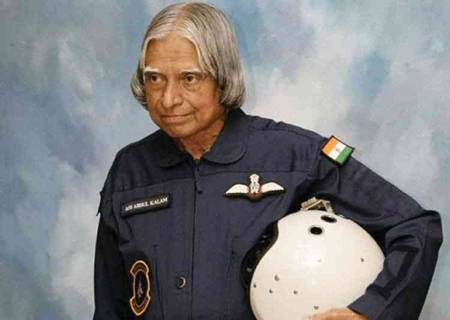
Kalam was the chief project coordinator of the Pokhran-II nuclear tests during his time as Secretary of the Defence Research and Development Organization (DRDO).
Following his university graduation, Kalam was keen on becoming an air force pilot. He traveled to Dehradun for his interview with the Air Force Selection board. Unfortunately, there were only eight positions available, and Kalam stood ninth in a group of twenty-five. Kalam recalled his immense disappointment at being unable to achieve his long-held dream. In My Life, he wrote, “I still remember the ache in my heart as I attempted to make sense of what happened.” However, this disheartening event turned into a spiritual experience which gave him a strong awakening. From Dehradun, Kalam traveled to nearby Rishikesh where he went to the Shivananda Ashram. Swami Shivananda advised Kalam, “Accept your destiny and go ahead with your life. You are not destined to become an air force pilot. What you are destined to become is not revealed now but it is predetermined. Forget this failure, as it was essential to lead you to your destined path. Search instead for the true purpose of your existence… surrender yourself to God.”
After hearing Swami Shivananda’s reassuring words, Kalam embarked on the next phase of his life as an aerospace engineer. At this point, Kalam connected with Vikram Sarabhai, chairman of the Indian National Committee of Space Research. Commonly regarded as the father of the Indian space program, Sarabhai had initiated space research and help-ed develop India into a nuclear power. In Wings of Fire, Kalam credits Sarabhai for giving physical shape to Prime Minister Nehru’s dream of India developing its own rocketry. Kalam wrote, “[Sarabhai’s] vision was very clear. If Indians were to play a meaningful role in the community of nations, they must be second to none in the application of advanced technologies to their real-life problems.”
In order to master the art of rocketry, Sarabhai sent Kalam for training at NASA’s headquarters in Virginia in 1963. Ramabhadran Aravamudan, one of Kalam’s team members at NASA, wrote a Time magazine article titled, “How India’s Late President Learned about Rocket Science with NASA.” He wrote, “[Kalam pursued the task] with single-minded devotion. He made his team work hard and set the benchmark for them by working twice as hard himself. He had a knack for getting things done and not letting failures deter his team.” In Kalam’s memory, NASA named a newly discovered bacteria on the International Space Station (ISS) as “Solibacillus Kalamii” in 2017.
In 1969, Kalam was transferred to the newly- expanded Indian Space Research Organization (ISRO) in Bangalore where he was appointed project director of India’s first Satellite Launch Vehicle (SLV-III). SLV was launched on July 18, 1980. The Rohini Satellite (RS-1) was placed in orbit, making India the sixth member of a club of space-faring nations. In 1981, Kalam was awarded Padma Bhushan, the third-highest civilian award, for his success with ISRO.
A model of humility
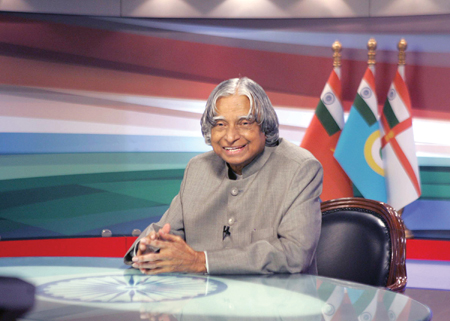
The final stretch of Kalam’s aerospace career was his time as Secretary of the Defence Research and Development Organization (DRDO) from 1992-1999. The highlight of these years was his role as chief project coordinator of the Pokhran-II nuclear tests. In May 1998, a series of five nuclear bomb test explosions were carried out of the Indian army’s Pokhran Test Range in Rajasthan. These tests demonstrated India’s capability to build fission and thermonuclear weapons.
[Right] As President of India, Kalam exuded both charm and gravitas.
In spite of national accolades, however, Kalam stayed firm in his belief that the recipe for success was not contingent on any professional title. In Wings of Fire, he wrote, “[performance dimensions] go beyond competencies such as the skills and knowledge of the individual. Performance dimensions are broader and deeper than what a person must know and be able to do in order to function well in his or her job. They include attitudes, values, and character traits.”
In 2002, Kalam was elected the 11th President of India. Kalam did not so much enter politics, as he was pulled into it by the then Prime Minister Atal Bihari Vajpayee. The India Today article, “Surprise Choice: Missile man APJ Abdul Kalam Set to Become 12th President of India” explains how Vajpayee and Home Minister L.K. Advani wanted a candidate who was neither part of the left nor “baptized in the Congress culture.” Thus, the National Democratic Alliance (NDA), consisting of nearly two dozen parties, unanimously selected Kalam as the presidential candidate due to his many services to the nation along with his growing popularity.
Kalam faced a mental dilemma when he was asked by Vajpayee to take on this monumental role as President of India. He felt, “I [am] enjoying an academic life, which is my passion and love, and I should not disturb it. The second view was that this was an opportunity to put forth the India 2020 vision in front of the nation and that I must jump at it.” After seeking the advice of several close friends in academia, civil service, and politics, Kalam told Vajpayee, “I consider this to be a very important mission and I would like to be an all-party candidate.”
He was the first scientist and bachelor to occupy Rashtrapati Bhavan, and only the third president to receive the Bharat Ratna, the highest civilian award granted for exceptional service and performance.
During his Presidential tenure, Kalam was regarded as “the people’s President.” According to an India Today article, “Abdul Kalam entered Rashtrapati Bhavan as a surprise consensus candidate, and left as a folk hero. [His] greatest achievement [was] to restore dignity, grace, and inspirational leadership to the presidency, things that were sorely lacking previously.” Instead of “wallowing in a luxury mansion accompanied by friends and family and being served hand and foot by an army of retainers,” Kalam redefined the office of the President of India, igniting minds and “throwing open those forbidding doors to a cross-section of India, mostly ordinary citizens. As a result, he “endeared himself to the public like no one before him, earning a pan-Indian following that would be the envy of most Bollywood stars.”
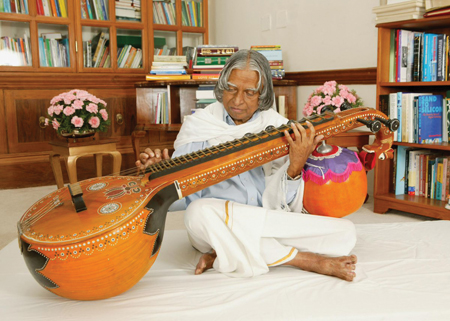
A Renaissance man, Kalam “recited classical Tamil poetry; played the rudra veena, a traditional South Indian instrument; and listened to Carnatic devotional music every day [while performing] his namaz, with no sense of incongruity.”
Kalam’s leadership style was defined by his concern for the common citizen combined with his fervent sense of nationalism. He was firmly convinced that in order to achieve national greatness, the lives and living conditions of the mass of the Indian population had to improve. In his article in The Hindu, “An Impact that will Endure,” Jayaprakash Narayan wrote, “His vision of India emerging as a developed economy within a generation and occupying her rightful place among global giants captivated the nation and electrified the imagination of youth.” Narayan continued, “Gandhiji gave us a sense of nationhood, [while] Kalam endeavored to inject optimism and show us a practical roadmap.”
In a YouTube video, “India Questions: Dr. Abdul Kalam,” he commented, “Many civilizations collapsed because [they] did not have a vision. Vision is very important for national development, and India has the vision to transform [it] into a developed nation.”
Being the change he wanted to see
Following his presidency, Kalam devoted the rest of his life to his true passion—inspiring young minds. He became a visiting professor at Indian Institute of Management at Shillong, at Ahmedabad, and at Indore; but his inspirational words transcended far beyond India’s borders. Deans of various overseas universities soon learned of his awe-inspiring presence, and many of them called him to lecture at their institutions.
In 2008, Kalam came to Los Angeles to lecture at my alma mater, the University of Southern California (USC). Invited by the Association of Indian Students, Dr. Varun Soni, Dean of Religious Life, was asked to welcome him. Dr. Soni is the first Hindu Dean of Religious Life at a major American university. He found that Kalam’s visit had a profound impact both on the students and on his career as a dean.
Dr. Soni remembers, “Although there was only half-a-day notice, hundreds of students were packed into a really small space. The room was for three hundred, and there were 700 people.” He continued, “Kalam was an engineer and a poet. Most students were from the Viterbi School of Engineering, but they were especially moved by his poetic language. He asked the students ‘What will you do for India to be developed in 2020? You are here to not just benefit your family and life, but also get a degree for India.’” According to Soni, “Students felt excited to put their knowledge into practice by helping India. I have never seen someone challenge our students that way. They felt inspired that they could be part of something bigger than themselves.” Soni reflected, “I am head of interfaith at USC and Kalam is a model. He could be right in the middle of politics but comfortable among different faiths, reconciling communities from different perspectives.” Soni continued, “After Kalam’s visit, I became an advisor to the Association of Indian Students and other South Asian organizations. I have been able to communicate much better with the students as a result of his visit.”
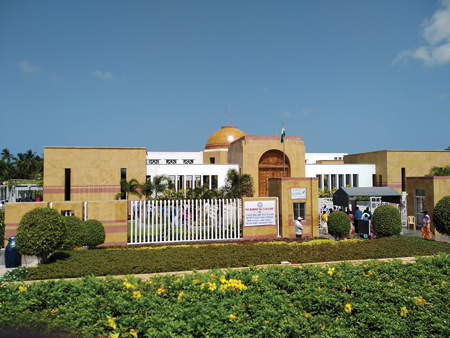
Dr. A.P.J. Abdul Kalam National Memorial in Rameswaram, his hometown.
Kalam’s life on this earth ended on July 27, 2015. He had traveled to Shillong in northeast India to give a lecture on “Creating a Livable Planet Earth,” at the Indian Institute of Management. Five minutes into the lecture, President Kalam suffered a heart attack and was pronounced dead an hour later. Kalam’s moment of passing, while igniting young minds, is especially powerful as it symbolizes what he wanted to be most remembered for.
Leaders from rival political parties and nations were united in their heartfelt sadness over Kalam’s passing. Manmohan Singh, Prime Minister at the time of Kalam’s presidency, remarked “Our country has lost a great human being. I greatly benefited from his advice as President of our country.” Nawaz Sharif,
Prime Minister of Pakistan, “prayed for eternal peace for the departed soul,” and Sheikh Hasina, Prime minister of Bangladesh, described Kalam as a “rare combination of a great statesman, acclaimed scientist, and a source of inspiration to the young people of South Asia. [His death is an] irreparable loss to India and beyond.” As a sign of respect, the Bhutanese government ordered the nation’s flags to fly at half-staff and lit 1,000 butter lamps in homage.
Today, in Rameswaram, Kalam’s hometown, is Dr. A.P.J. Abdul Kalam National Memorial.
The memorial keeps Kalam’s legacy alive by representing everything he stood for. At the entrance is a statue of Kalam playing the veena, one of his many passions. The monument displays models of rockets and missiles that Kalam worked on, along with paintings depicting his life. Each stone in the memorial is representative of Kalam’s dream of a united India. Pawan Gupta, who directed the construction, said, “[Kalam] always admired the different aspects in our culture. [Thus], we have tried to integrate all of it in this monument.”
When my curiosity about Kalam was piqued after noticing his prominent picture at Mayura, I did not expect that learning about the journey of this brilliant man would prove to be so transformative. His spiritual wisdom has given me a roadmap of how to navigate my time on Earth in a purposeful, optimistic, and humble manner.
Nikhil Misra-Bhambri is a freelance journalist living in Los Angeles, California. He graduated in history from the University of Southern California (USC) and writes about relationships between cultures, cuisine, music, and history.
Enjoyed reading Khabar magazine? Subscribe to Khabar and get a full digital copy of this Indian-American community magazine.
blog comments powered by Disqus










